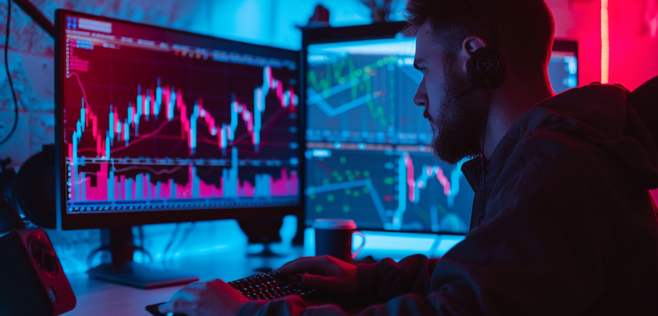Published: 31 Aug 2024
The Benefits of Trading Crypto Futures: Hedging, Leverage, and Speculation

Cryptocurrency futures trading has become an essential component of the digital asset market, offering traders and investors unique opportunities to manage risk, maximize profits, and speculate on price movements without owning the underlying asset. Unlike traditional spot trading, where assets are bought and sold for immediate delivery, futures trading involves contracts that obligate participants to buy or sell an asset at a predetermined price on a future date. Understanding the benefits of crypto futures is crucial for those looking to diversify their trading strategies and enhance their portfolio management.

Getting Started with Crypto Futures: Key Points to Know
Crypto futures are derivative financial contracts that represent an agreement to buy or sell a specific cryptocurrency at a predetermined price on a future date. Unlike spot trading, where the actual asset is bought or sold for immediate settlement, futures trading involves speculating on the future price movement of an asset. This allows traders to profit from both rising and falling markets without the need to directly own the cryptocurrency. Futures contracts can be settled either physically, with the actual delivery of the asset, or more commonly, in cash, where only the price difference is settled.
There are several key differences between futures and spot trading in the crypto market. In spot trading, investors must fully own the asset, and they profit only when the price of the asset increases. In contrast, futures trading allows traders to use leverage — borrowing funds to amplify their positions — enabling them to profit from smaller price movements. This leverage also means that futures traders can enter larger positions with less capital compared to spot trading.
In the crypto market, futures contracts are standardized agreements listed on exchanges like Binance and BitMEX. These contracts have specific details, including the quantity of the underlying asset, the expiration date, and the settlement process. Traders use these contracts to hedge against price volatility, speculate on price changes, or gain exposure to the market without owning the underlying asset, providing flexibility and a range of strategic options.

The Benefits of Trading Crypto Futures
Crypto futures trading offers several unique advantages that appeal to different types of market participants, from risk-averse investors to aggressive speculators. Let's explore the core benefits of trading crypto futures, focusing on hedging, leverage, and speculation.
Hedging
Hedging involves using futures contracts to reduce risk by offsetting potential losses in an investor's portfolio. In the context of crypto futures, traders and investors use this strategy to protect their holdings against adverse price movements in the volatile cryptocurrency market. For example, a Bitcoin holder concerned about a potential price drop might enter a short futures contract to mitigate losses. Hedging can provide stability in uncertain markets, helping traders navigate volatility without liquidating their assets.
Leverage
Leverage is a powerful tool in futures trading that allows traders to control a larger position with a smaller amount of capital. This amplifies potential profits but also increases the risks. For instance, with 10x leverage, a trader can open a position worth $10,000 with only $1,000 in capital. Leveraged trading strategies, such as margin trading or swing trading, enable traders to capitalize on both upward and downward market movements. However, effective risk management is crucial, as leverage can also magnify losses.
Speculation
Speculation is a fundamental aspect of crypto futures trading, where traders bet on the future price movements of an asset without actually owning it. This allows traders to profit from both rising and falling markets. By analyzing market trends, technical indicators, and macroeconomic factors, speculators use futures to gain exposure to potential price movements and maximize their returns. Examples of speculative strategies include momentum trading, arbitrage, and directional bets, each offering varying degrees of risk and reward.
These benefits illustrate why crypto futures trading has become a popular choice among traders and investors looking to diversify their strategies, manage risk, and maximize potential returns in the dynamic cryptocurrency market.

Comparing Crypto Futures with Other Trading Instruments
In the diverse world of cryptocurrency trading, various instruments offer different benefits and risks. Crypto futures, spot trading, options, and other derivatives each have unique characteristics that appeal to different types of traders and investors. Understanding how these instruments compare is essential for choosing the right strategy.
Comparison with Spot Trading
Spot trading involves buying and selling the actual asset, like Bitcoin or Ethereum, at the current market price. In contrast, crypto futures allow traders to speculate on the future price of an asset without owning it. While spot trading is straightforward and has no expiry date, futures offer higher leverage and the ability to profit from both rising and falling markets.
Advantages of Futures Over Spot Trading
- Greater leverage for higher potential returns
- Ability to short the market and profit from price declines
- Hedging opportunities to manage risk
Comparison with Options
Options are financial derivatives that give traders the right, but not the obligation, to buy or sell an asset at a specified price within a certain timeframe. Unlike futures, where contracts must be settled at expiry, options provide more flexibility. However, futures generally offer higher liquidity and simpler pricing structures compared to options.
Advantages of Futures Over Options
- Simplicity and ease of understanding for new traders
- Higher liquidity and tighter spreads
- More predictable risk and reward structures
Comparison with Other Derivatives
Other derivatives, such as perpetual swaps and tokenized assets, offer unique trading opportunities. Perpetual swaps, for example, are similar to futures but have no expiry date and use funding rates to maintain the price close to the spot market. Crypto futures are often preferred for their traditional structure, regulatory oversight, and clear settlement processes.
Advantages of Futures Over Other Derivatives
- Defined contract expiry provides certainty in trading strategies
- Established market infrastructure and accessibility
- Clear regulations in major exchanges enhance security and reliability
Scenarios Where Trading Futures Might Be More Beneficial
- For traders seeking high leverage and margin trading opportunities
- For investors looking to hedge against portfolio risk in volatile markets
- For those aiming to profit from short-term price movements without holding the underlying asset
Crypto futures stand out due to their flexibility, risk management features, and leverage opportunities, making them a powerful tool in various trading scenarios. Understanding their strengths relative to other instruments can help traders and investors make more informed decisions in the ever-evolving crypto market.

Risk Management in Crypto Futures Trading
While trading crypto futures offers significant potential for profit, it also comes with a unique set of risks that traders must navigate carefully. Effective risk management is crucial for safeguarding capital and ensuring long-term success in this volatile market.
Overview of the Risks Associated with Futures Trading
Futures trading involves high leverage, which can amplify both gains and losses. The volatile nature of cryptocurrency prices can lead to rapid and unexpected market swings, increasing the risk of significant financial losses. Additionally, factors like market manipulation, low liquidity, and the complexity of futures contracts add layers of risk that traders must understand.
Key Strategies for Managing Risk
- Stop-Loss Orders
One of the most effective tools for managing risk in futures trading is the stop-loss order. This order automatically sells a position when it reaches a predetermined price level, helping traders limit potential losses and protect their capital in a market downturn.
- Position Sizing
Proper position sizing is critical to risk management. Traders should avoid overexposing their portfolio to a single trade or market. By allocating a reasonable portion of their capital to each position, they can reduce the impact of potential losses.
- Diversification
Diversifying across different assets or trading instruments can help mitigate risk. While some positions may incur losses, others might perform well, balancing the overall portfolio. Diversification is a core principle in reducing systemic risk in futures trading.
The Importance of Understanding and Controlling Leverage-Related Risks
Leverage is a double-edged sword in futures trading. While it can amplify profits, it can also magnify losses, especially in volatile markets. Traders must understand the risks associated with high leverage and use it judiciously. Implementing conservative leverage ratios, maintaining sufficient margin, and regularly monitoring market conditions can help control leverage-related risks effectively.
Successful futures trading relies on robust risk management practices. By employing these strategies — such as using stop-loss orders, optimizing position sizes, diversifying assets, and managing leverage — traders can navigate the complexities of crypto futures markets more confidently and protect themselves against potential pitfalls.

Real-World Examples of Crypto Futures Trading
Understanding the real-world applications of crypto futures trading can provide valuable insights into how experienced traders and investors navigate this complex market.
Case Studies Showcasing Successful Hedging, Leverage, and Speculation Strategies
One prominent example is how institutional investors use crypto futures to hedge against market volatility. For instance, during periods of high market uncertainty, some funds have successfully employed short futures positions to protect their portfolios from potential downturns. This approach allows them to lock in prices and manage downside risk effectively.
Another example is the use of leverage by professional traders to amplify their returns. In a bullish market trend, traders often take advantage of high leverage to open large positions with relatively small capital. A notable case is the 2021 Bitcoin bull run, where many leveraged traders achieved significant profits by riding the momentum, leveraging their positions at the right time.
Speculation is another strategy where traders seek to capitalize on short-term price movements without holding the underlying asset. A well-known instance is traders speculating on Bitcoin's price during its volatile phases, where futures contracts allowed them to benefit from rapid price changes without owning any actual Bitcoin.
Lessons Learned from Real-World Trading Scenarios
From these examples, it's evident that while the potential for profit in crypto futures trading is high, the risks are equally significant. One key lesson is the importance of timing in futures trading. For leveraged trades, the entry and exit points must be carefully planned to avoid liquidation during sudden price swings.
Another lesson is the necessity of a disciplined approach to risk management. Traders who fail to use tools like stop-loss orders or who over-leverage their positions often face substantial losses. The stories of traders losing significant amounts due to unchecked leverage and lack of proper risk controls serve as cautionary tales for others in the market.
Analysis of Market Trends Impacting Crypto Futures Trading
Market trends such as macroeconomic events, regulatory changes, and technological advancements play a crucial role in influencing futures trading strategies. For example, during periods of regulatory uncertainty, there is often increased market volatility, which can affect futures prices and trading volumes. Similarly, the introduction of new futures products and trading platforms has expanded the range of strategies available to traders, enabling more sophisticated approaches to speculation and hedging.
By examining these real-world examples, traders and investors can better understand the dynamics of crypto futures markets and apply these lessons to their own trading strategies. Understanding both the opportunities and risks associated with hedging, leveraging, and speculating can help traders navigate the complexities of futures markets with greater confidence and effectiveness.

Future Trends in Crypto Futures Trading
As the cryptocurrency market continues to evolve, the landscape of crypto futures trading is set to experience significant changes driven by emerging trends, innovations, and regulatory developments. Understanding these trends is crucial for traders looking to capitalize on future opportunities in this dynamic market.
One of the most notable emerging trends in the crypto futures market is the increasing integration of advanced technologies such as artificial intelligence (AI) and machine learning. These technologies are being used to develop more sophisticated trading algorithms that can analyze vast amounts of market data and execute trades with greater precision and speed. This innovation is expected to further enhance the efficiency and profitability of futures trading strategies, providing traders with a competitive edge.
Another trend to watch is the growing diversification of futures products. We are already seeing a range of new products being launched, such as micro-futures contracts and futures tied to emerging cryptocurrencies beyond the major players like Bitcoin and Ethereum. This diversification allows traders to explore new markets and develop more nuanced trading strategies that align with their risk tolerance and market outlook.
Regulatory developments also play a significant role in shaping the future of crypto futures trading. As regulators around the world continue to grapple with how to oversee and manage cryptocurrency markets, we can expect to see clearer frameworks and guidelines that could impact futures trading. Potential regulations may address issues such as leverage limits, transparency, and market manipulation, all of which could influence trading practices and the overall market structure.
Looking ahead, the crypto futures market is poised for substantial growth and evolution. With the introduction of new technologies, products, and regulatory frameworks, traders will have more tools and strategies at their disposal to navigate this complex market. The continuous development of trading platforms and infrastructure, along with increasing institutional participation, will likely lead to greater market liquidity and more efficient price discovery.

Conclusion
The strategic advantages of trading crypto futures — hedging, leverage, and speculation — make them a compelling option for traders looking to diversify their portfolios and capitalize on the unique opportunities presented by the cryptocurrency market. However, it is essential for traders to stay informed about emerging trends, innovations, and regulatory changes that could impact the future of crypto futures trading. As the market continues to mature, those who are well-prepared to adapt to these changes will be best positioned to succeed in this evolving landscape.

 Get RateX Pro
Get RateX Pro

 06 Jun 2024
06 Jun 2024


